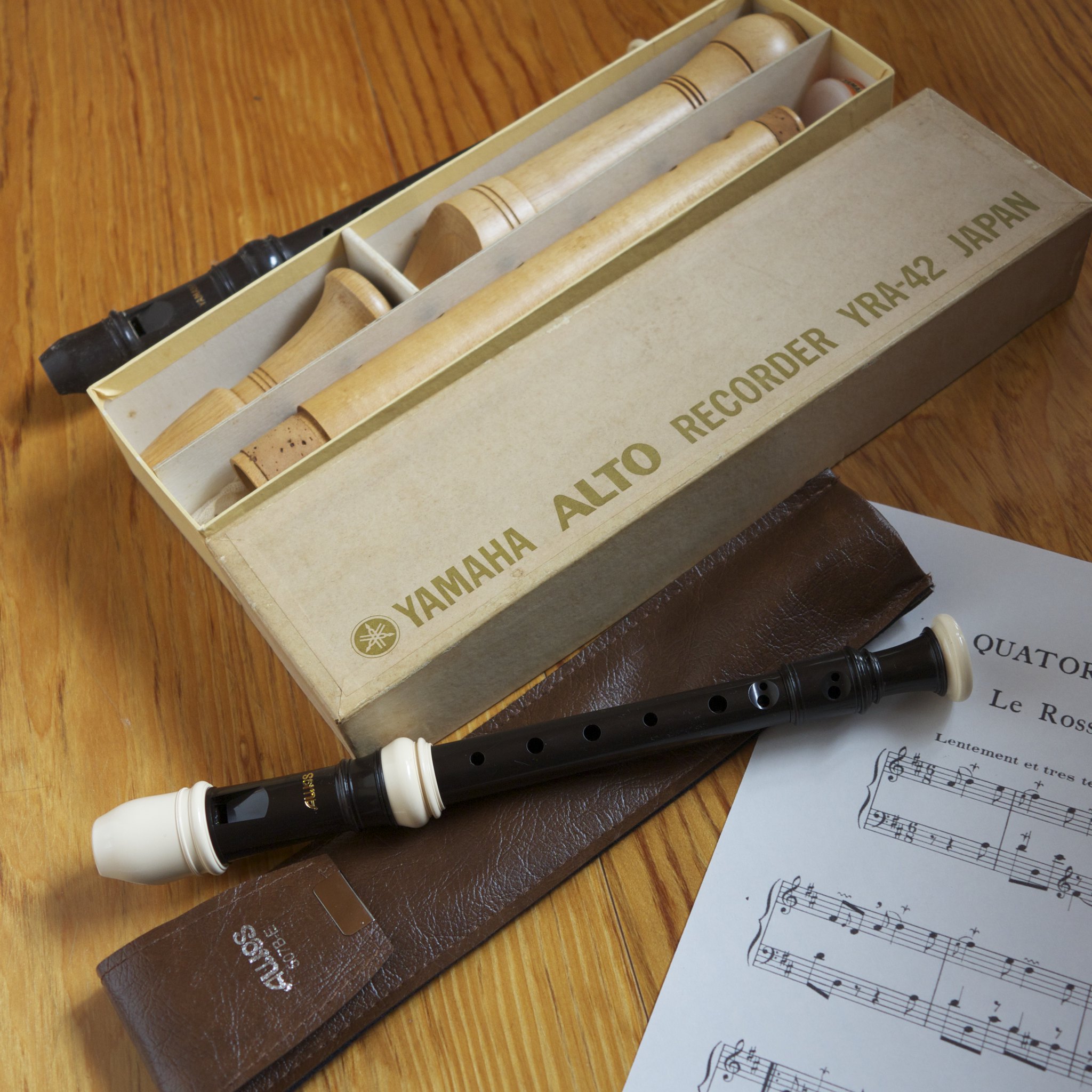The idea of modern or flute extended techniques, or any instrument for that matter, is the concept that there is a category of techniques for the instrument that are not “traditional.” These techniques are rarely, if at all, found in classical literature, and are used almost exclusively in solo or small ensemble literature written within the last seventy years. While seventy years is a long time, in the history of western art music, this is just a blip on the radar.
Flutists in particular saw an explosion in modern technique development throughout the second half of the twentieth century. Most flute professionals point to The Other Flute: A Performance Manual of Contemporary Techniques by Robert Dick (1975) as the handbook for modern techniques on the instrument, though other references do exist.
Robert Dick produced an array of solos and etudes utilizing these techniques, helping greatly to standardize and solidify these types of techniques. Since the release of The Other Flute, additional techniques have been introduced into the repertoire and standardized over the last few decades.
The list below is by no means exhaustive, but introduces you to some of the most well known techniques in this category.
Natural Harmonics
If you think about handing a recorder to a young child, the first thing that they do is blow into the instrument, typically producing a high piercing sound. Beginner recorders require quite a bit of control to play properly to not overblow the pitch. Those high pitches when the instrument is overblown are the harmonics, and can be utilized on a flute for tone color variations and different levels of dynamic control.
When discussing the science of sound, particularly when looking at stringed instruments, it is largely rooted in the study of harmonics. When discussing the tone quality or color of an instrument, any instrument, it is the intensity and distribution of those harmonics that gives it its particular color.
While I am not going to go into great detail about harmonics and tone color, as that could be several articles long, we know that every note is made up of a fundamental pitch and a combination of pitches that sound or resotate a multiple of the fundamental pitch’s frequency.
For example, one of the lowest notes on the flue is C4 (middle C). This fundamental pitch, when played is made up of the notes seen here:

A flutist can access these notes by using the fingering for the fundamental, and then making embouchure and air flow adjustments to reach the higher harmonics. It required some skill to land on the desired pitch and control it’s dynamic quality.
A flutist can use harmonics to their advantage in any piece, creating a softer sounding high note by utilizing harmonics, or it can be called for by a composer to create a particular effect.
Quarter Tones and Microtones
The standard chromatic scale of the keyboard has 12 evenly spaced notes. Quarter Tones are the notes evenly spaced between those 12 notes, creating a total of 24 notes in the quarter-tone scale. Microtones are various, intentional, fluctuations of pitch to fall between the notes of a chromatic scale.
To someone whose musical ear is rooted in western harmonic tradition, these pitches sometimes just sound out of tune instead of intentional. However, there are modern composers who are writing for quarter tones and even microtones, resulting in flutists having to learn how to play those notes.
This is done by a combination of alternate fingerings and embouchure control. Many modern flute composers will indicate a desired fingering in their piece, but there are several reference books that cover a wide range of possible fingering for different pitches. Robert Dick’s The Other Flute contains several charts for quarter tones and microtones, but James Pellerite’s A Modern Guide to Fingerings for the Flute is probably the most comprehensive.
Glissandi (Open Hole Flutes Only)
Trombones and Fretless String instruments are capable of producing a continuous glissandi as part of their standard techniques, but due to the nature of most wind instruments being keyed or valved, flutes do not naturally have that ability.
When flutists typically think of glissandi, it generally means playing a sequence of diatonic or chromatic notes in succession from a fixed starting point to a fixed ending point. However, in the realm of extended techniques, it is possible on an open hole flute to create smooth continuous glissandi between various notes.
Now, given the nature of the flute, these ranges of continuous glissandi are limited to about a third and are only available between very specific pitch ranges. Anyone wishing to compose for this effect will need to consult a reference guide, such as The Other Flute to ensure the desired effect is possible.
Another alternative to a continuous glissandi is a fairly recent invention: the Glissando Headjoint. Not a standard piece of flute equipment, but definitely adds a whole layer of possibilities to flute playing.
Multiple Tones
Playing more than one note at the same time seems like an impossible task on the flute, but it has become quite common in modern flute literature to call for multiple tones, also known as multiphonics or double stops.\
The basic principle is related to harmonics as discussed earlier. You play a particular note, and adjust your embouchure to sound a note that is one of the harmonics found within the fundamental.
In order to sound two notes at the same time, the embouchure changes, opening up to essentially capture two (and sometimes three) notes of the harmonic sequence at the same time.
For example, We know that by utilizing a C4 fingering, a flutist can access the harmonics C5, G5, C6, E6, G6 (sharp), etc. With an adjusted embouchure, a flutist could play any two of the adjacent harmonics at the same time:

Flutter Tongue
While the flutter tongue is considered an extended technique by many, it is one that has been sparsely used throughout classical literature, most notably in Tchaikovsky’s The Nutcracker.
This effect is produced by rolling your tongue like in a Spanish R. You do this while playing a note, to create a fluttering or buzzing effect. In a way, it is the flute’s version of a violin tremolo.
It can be a bit challenging to master for some players, especially getting the tone to stay strong while executing the technique, but it is likely the one extended technique on this list that all fluists should strive to execute.
Key Clicking / Key Slaps
This technique is used to various degrees to leverage the percussive sound of the keys clicking and the resonance of the flute when the key is clicked. While flutists usually spend years ensuring that there is minimal distance between their fingers and keys in order to play notes quickly and cleanly, key clicking requires a much more forceful and deliberate playing style.
Due to the nature of the instruments, key clicks are only audible in the first octave of the instrument, and even then, typically with F4 and below, as there is more resonance with the instrument.
Additionally, the player can cover the embouchure hole, which adds additional resonance and serves to amplify the sound of the key slap, but it can also lower the pitch by as much as an octave. Players and composers need to experiment to get the desired sound and pitch.
Tongue Stop
When the flutist places their mouth around the embouchure hole and forcefully propels their tongue into the embouchure hole, it creates a percussive sound that resonates throughout the instrument.
This technique can be used with all standard fingerings from B3 to Eb5. When performed, the note produced is a major 7th below the note being fingered.
This technique has been named many things in various extended technique literature, tongue ram and tongue thrust being two of the more common in addition to tongue stop.
Singing While Playing
This technique is a bit misleading, as it may be more accurate to call it humming while playing. A flutist can learn to hum a line of music at the same time as playing a line of music.
What is particularly interesting about this technique is that it tickles. It is not so bad if the music being hummed and played are in unison or in octaves, but if different intervals are being used and the overtones become dissonant, that dissonance seems to be felt right at the lips, which can make this technique more challenging to sustain the pitch and tone quality of the flute.
Also, for anyone who has ever tried to rub their stomach and pat their head at the same time, you’ll understand the feeling of playing one line of music and singing another. Flutists who are also skilled pianists may have an easier time with this, but each person's experience with singing and playing is different, and flutists who do not play any other instrument are not as practiced with the skill.
This technique can be used to produce some really interesting effects, as the singing can change the tone color, and the resonance of the harmonics between the voice and the flute are rather distinct from other types of techniques.
Conclusion
I have attempted to cover some of the major extended flute techniques here. You can read several reference materials and visit countless websites, and still never find a complete list of techniques utilized, as flute composers and performers are coming up with new creative ways to make music with the instrument.
What this does show us is that music is an ever changing art, and this is just a small sample on how one instrument which has been in western music for centuries, continues to develop new ways of expression."




